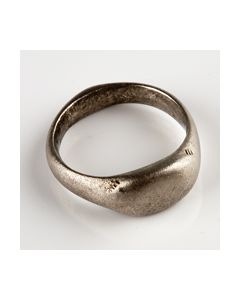Search results for: 'römisch'
-
 Römischer Ring aus Silber
Römischer Ring aus SilberRömische Kaiserzeit, möglicherweise aus der keltischen Provinz oder Provinznähe. Ringband geht nahtlos in die Ringplatte über. Theoretisch auch heute noch als Amulett oder Fingerring tragbar. Innendurchmesser 17mm bis 18mm.
Price: on request Roman discus fibula with color glass paste
Roman discus fibula with color glass pasteSpannende Fibel mit Sterndekor und Glaspaste. Eine Weiterentwicklung keltischen Kunsthandwerks in der Zeit römischer Herrschaft. Gut dokumentierter Typ aus dem 2. Jh. v. Chr. mit Verbreitung in weiten Teilen Europas.
Price: on request Gallo-Roman animal fibula
Gallo-Roman animal fibulaZoomorphe Fibel mit Wildtier als Motiv. Schmuckstück mit religiöser Symbolik, vergleichbar einem Kreuzanhänger bei heutigen Christen. Gefertigt im 1. bis 3. Jh. n. Chr. in Gallien.
Price: on request Roman sandal sole type fibula
Roman sandal sole type fibulaDie Form wird in der Literatur als Schuh- oder Sandalensohle bezeichnet. Der sehr dekorative Fibeltyp war extrem beliebt und im zweiten Jahrhundert weit verbreitet. Er stammt aus den nördlichen römischen Provinzen.
Price: on request Ancient brooch of a fabulous creature
Ancient brooch of a fabulous creatureRare Hippocampus brooch with elaborate inlays of multi-coloured glass paste and metal. Great example of the brooch manufacturing of Roman Gaul during the mid 1st cent. AD.
Price: on request Dolphin brooch from Roman Britain
Dolphin brooch from Roman BritainThe so-called dolphin brooch is very British. This specimen was probably made by the Celtic Corieltauvi tribe, shortly after the arrival of the Romans in the middle of the 1st century. Published in two works by Richard Hattatt.
Price: on request Disc brooch from Roman Britain
Disc brooch from Roman BritainNicely enameled brooch with a Romano-Celtic sunburst design. From the 2nd century AD. Published in two stardard works on ancient brooches by Richard Hattatt.
Price: on request Trumpet brooch with Celtic decorations
Trumpet brooch with Celtic decorationsUnusual and rare variant of high importance, published several times. Beautiful silver inlays on the bow showing tendrils in Celtic style. From the 1st century.
Price: on request Roman Celtic seal box
Roman Celtic seal boxLozenge shaped body with lid in Celtic design. A piece from the 1st or 2nd century, found near the Celtic settlement and later Roman town of Lindum. Published in a standard work by Richard Hattatt.
Price: on request

